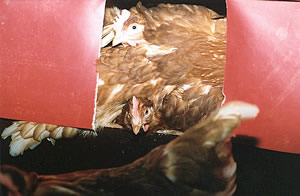
by Ranger editor John Widdowson
When our esteemed team of vets write in the Ranger each month we are often told that one of the major disease prevention measures is avoiding stress amongst our hens (just read this month’s offering for confirmation of that fact).
But such advice, while sound, can still leave producers looking for other answers to a problem simply because ’stress’ amongst a flock is not always that easy to spot or indeed to define. However, on two occasions this year I’ve lost a significant number of hens and in both instances it could be directly attributed to a stress situation.
The first time it was in a flock of birds aged 51 weeks, laying well and with good egg quality. We suddenly started to lose 5-6 birds a day and I suspected a peritonitis problem, which, although not uncommon amongst free range birds, is not something we suffer too much from except occasionally towards the end of lay.
A post mortem by the vet confirmed chronic peritonitis was indeed the cause of death and the birds were prescribed a course of in-feed antibiotics in the form of chlortetracycline. But while this treatment temporarily slowed the mortality, it failed to solve the problem. Back to the vet it was, and a further PM confirmed the original diagnosis.
There had to be a reason why this apparently healthy, well-performing flock was experiencing such high mortality. Following discussions with my vet at the St David’s Practice in Exeter we struck on a possible cause, for it seemed I had innocently introduced a routine which was now a cause of stress to the flock.
I had started to give a daily scratch feed outside in the late afternoon. This had come about following a lot of media activity we had on the farm in early summer following the launch of Woodland Eggs. Photographers were naturally keen to have plenty of hens in shot and in order to get the hens to oblige I began to throw a handful of corn on the ground. Because this went on for a week or so the hens got quite used to it and would be waiting in anticipation every time I approached. Not wanting to disappoint them I continued with the practice, always careful to scatter the wheat over a large area and on clean pasture.
Incredible as it may seem I had unwittingly created the stress situation that was leading to the untimely death of so many hens. There was the stress of waiting for me to arrive, the running across the paddock when I did so, and then the ensuing scramble to get the corn.
As the vet agreed that this could indeed be the root of the problem I immediately ceased doing it. But I knew that it was not going to put things right straightaway as the hens now had to go through the stress of waiting for the scratch feed but not receiving it. In fact it was well over a month before the hens stopped chasing me around the paddock and mortality levels returned to normal.
My second experience of a stress situation leading directly to a mortality problem doe not leave me feeling quite as bad for this time it was not initiated by my own actions. A young flock coming into lay began over-crowding in one section of the nest boxes. As readers will know this is not an unusual problem during the first few weeks of lay but this was quite extreme and went on for two weeks or more. It also coincided with the loss of two to three birds a day at an age when really there should be no mortality.
I dutifully took them off to the vets for examination but this time I knew what to expect. Once again it was peritonitis leading to death from septicaemia and I agreed with the vet that there was little point in prescribing antibiotics when the underlying cause of the problem was clearly the stress involved associated with crowding in the nests.
Producers who have experienced this problem will know there is little you can do apart from regularly visit the nests and thin the birds out. But for the pullet that thinks it has settled down somewhere quiet to lay its egg only to be hoofed out by me, this action is equally as stressful as that of crowding in the nest. I knew in time the birds would spread out throughout the rest of the nests and they did. At the same time the mortality ceased.
My experiences this year highlight the fact that stress really can be a killer. Though it may not always be obvious, it is always worth looking hard at what is actually occurring in the lives of our flocks. The answer to a problem may be just under our nose and not in a dose of CTC after all.
